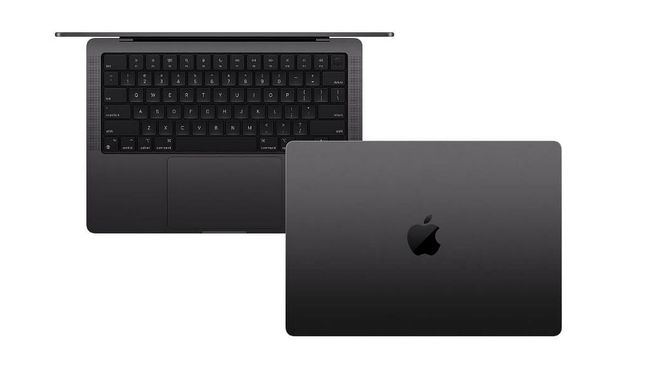Apple Announces New M3 Chip Lineup For The MacBook Pro And iMac
It really is scary fast.

In the ghostly haze of October’s final eve, as jack-o-lanterns cast flickering shadows and ghouls roamed the night, another kind of magic was unveiled to the world. No, not a witch’s brew nor a vampire's curse, but a new family of Apple's M3 chips that are truly "Scary Fast" — not unlike the title of the Keynote event.
Keeps up with you
Apple continues to redefine the boundaries of technology with the unveiling of the M3, M3 Pro, and M3 Max chips. These pioneering chips mark a significant milestone, being the first in the personal computer industry to harness the advanced 3-nanometer process. This state-of-the-art approach promises a remarkable surge in speed and efficiency, achieved by densely populating more transistors within an incredibly compact space.

Related article: 10 Things You Need To Know About Apple’s New iPhone 15 and iPhone 15 Pro
Diving into their graphical prowess, the M3 chips unveil a next-generation GPU architecture that brings to the table features like Dynamic Caching, hardware-accelerated ray tracing, and mesh shading. Dynamic Caching, a standout feature, intuitively allocates memory in real time, optimising GPU utilisation and supercharging performance levels. This is complemented by ray tracing, which infuses the Mac universe with lifelike imaging, and mesh shading that lays the foundation for intricate visual spectacles in games and graphics-intensive applications.
But it's not just about the graphics. The M3 lineup boasts CPU cores that outpace the M1 series by 30 to 50 percent. Apple's Neural Engine, tailor-made for AI, achieves speeds that are a whopping 60 percent faster than before. This opens doors to rapid AI image processing tools, cutting-edge scene edit detection, and much more. An overhauled media engine also takes centre stage, supporting a range of popular video codecs and, for the first time, introducing AV1 decode for an enhanced video playback experience.

The chips’ Unified Memory Architecture is another feather in Apple's cap. It enables all technologies within the chip to access a shared data pool, skyrocketing performance and efficiency. This is especially noteworthy for professionals who can now harness up to a staggering 128GB of memory (for the M3 Max Chip), facilitating workflows that were previously deemed impossible on a laptop.
Zooming in on the individual stars of the show: The M3 features 25 billion transistors, a 10-core GPU that renders graphics 65 percent faster than the M1, an 8-core CPU, and supports up to 24GB of unified memory. The M3 Pro, with its 37 billion transistors and an 18-core GPU, delivers graphics that are up to 40 percent faster than the M1 Pro and boasts a 12-core CPU. It also expands unified memory support to 36GB. The pièce de résistance, M3 Max, is an absolute powerhouse. It pushes the envelope with 92 billion transistors, a 40-core GPU that's up to 50 percent faster than the M1 Max, and a 16-core CPU.
Which one should you pick?

With the introduction of the M3 Chip family comes the launch of its updated MacBook Pro line up. The 14-inch MacBook Pro, designed with general users, students, and budding creators in mind, showcases the M3 chip. This model is not only adept at handling daily computing needs, but it also ensures outstanding performance when running professional applications and games.
Related article: Is The Apple Watch Hermès Collab Over?
Taking a step further, the 14 and 16-inch MacBook Pro models powered by the M3 Pro are tailored for those with rigorous workflows, including coders, designers, and researchers. These models provide an enhanced performance boost, coupled with increased unified memory support.
For those who require the pinnacle of computing prowess, the 14 and 16-inch MacBook Pro with the M3 Max is the answer. Catering to advanced users such as machine learning developers, 3D artists, and video editing professionals, this beast of a machine offers robust GPU and CPU capabilities, and the ability to support up to 128GB of unified memory.
Once you go black...

A striking update to the MacBook Pro's aesthetic is the introduction of a new color: Space Black. This elegant, dark aluminum finish is exclusively available for the MacBook Pro models that feature the M3 Pro and M3 Max chips. The breakthrough chemistry behind this color not only delivers a sophisticated look but also offers an added advantage of reducing visible fingerprints. It's a refreshing twist on Apple's traditional silver and space grey hues, giving consumers an additional layer of personalisation for their device.
The new 24-inch iMac with M3 is available to order Wednesday, 1 November, and available in stores on 7 November. The 14-inch MacBook Pro with M3 starts at $2,299; 14‑inch MacBook Pro with M3 Pro starts at $2,899; and the 16‑inch MacBook Pro starts at $3,599.
Colour me impressed

The Apple 24-inch iMacs are now upgraded and fitted with the new M3 Chip. The leap from the M1 to the M3 gives the new iMac a performance that’s up to four times faster than the top-tier 21.5-inch Intel model, and 2.5 times faster than the most sought-after 27-inch Intel versions.
It's not just about raw speed either. The iMac's 4.5K Retina display, boasting over 11.3 million pixels, brings visuals to life with unparallelled clarity and vibrancy. This, combined with its faster wireless connectivity and flawless integration with the iPhone, makes up the ecosystem that most Apple users have come to love and rely on.

With an 8-core CPU, with upgradable option of up to 10-core GPU, and support for up to 24GB of unified memory, the M3 is designed to handle every demand thrown its way. Users get to experience the benefits of this power in every task they undertake, from juggling multiple apps to diving deep into graphic-intensive projects.
The new 24-inch iMac with M3 is available to order Wednesday, 1 November, and available in stores on 7 November. The iMac with 8-core GPU starts at $1,899 while the 10-core GPU option starts at $2,199.